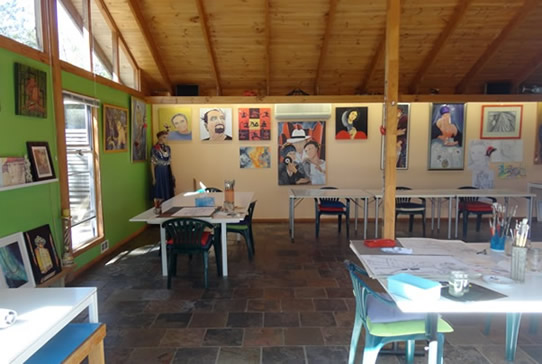GalleryGiselle.com - Art Studio ... for the love of Art - Australia
Acrylic Art Classes Gold Coast Hinterland
Learn to draw or paint in an art inspired, creative atmosphere and
air-conditioned Studio on 5 acres of Gold Coast Hinterland
serene and beautiful landscaped art sanctuary gardens.
Celebrating 25 years of Personalised Creative Art Classes
Join Giselle's Acrylic Painting Classes
 Creative Acrylic Art Classes
Creative Acrylic Art Classes
Call Giselle to join her Art Classes: 0407 630 776 ... or E-mail
... from total beginners to advanced, Giselle will teach all levels.
If you are a total beginner, meaning having no experience with any type of drawing or painting, I recommend you start with drawing classes before you venture into Acrylic Painting.
If you have been drawing or painting a bit, or if you are an experienced painter and like to explore the acrylic medium, you are most welcome to join my classes, and start on exiting acrylic projects.
All art classes are based on individual teaching within a class environment.
You can start at anytime and you also can change mediums at any time ...
Acrylic Art Classes:
3 1/2 hour lessons - only $40
Classes: Tuesdays & Wednesdays from 9.30am to 1.00pm
-
Air conditioned Artist Studio - 5 acres of Beautiful Landscape Gardens
-
Enjoy a cup of freshly brewed coffee or tea at our most enjoyable rest break.
Contact Giselle by e-mail or call 0407 630 776
Studio Location:
-
3155 Beechmont Road, Canungra, Witheren, Queensland 4275 - Australia
click > see the contact page for a location map -
Canungra is within 20 to 30min. driving range to: Beaudesert | Beechmont | Beenleigh | Coomera | Gold Coast | Helensvale | Hope Island | Jimboomba | Mudgeeraba | Oxenford | Nerang | Mt Tamborine | Tamborine Village | 1 hour from Brisbane |
Click the name of your location to find driving direction to Giselle's Art Classes.
Acrylic Painting Techniques
The most striking feature of acrylic paint is its versatility!
When acrylic paint is diluted with water, it handles similarly to water-colour, when thinned with a smaller amount of water, acrylic can have a superb gouache like consistency. If you add even less water, or thin it with acrylic medium you will have a paint quality like that of oil.
If you add retarder and or gel medium, or paste extender, you have a medium that has even more body than oil.
If you are interested in working with collage techniques, there is no better medium than acrylic. It is an excellent adhesive and can be used to bind papers, fabrics, sand and any other materials to the painting surface.
Understanding the Medium:
- Acrylics were invented in the 1950s. They are as versatile as Oil and Watercolour and have some unique qualities of their own.
- Acrylic is a polyacrylicate polymer - a modern, manufactured product derived from synthetic resin.
- Acrylic paint is made by dispersing pigments into an emulsion of acrylic resin and water.
- Acrylic paint becomes slightly darker as it dries (allow for these colour changes).
- Generally, you can mix paints and media products by different manufacturers without problems.
Advantages of Acrylic Paints:
- Very quick drying time.
- Can be over painted as much as you like.
- Can be painted on more or less any surface, from paper to board to canvas.
- Needs no surface preparation, or priming, but most artist prefer a prepared surface.
- Water base, and can be thinned down with water.
- Brushes can be washed out in water.
- Note: Brushes must be left in a container with water or washed regularly.
Acrylic Mediums: (media)
Acrylics can be used directly from the tube or thinned with water. But the real fun starts when you begin to add media.
- Mediums are used to make acrylic even more versatile.
- Mediums can improve the flow and brushability, they help to maintain adhesiveness and increase transparency.
- Mediums are also designed to create special characteristics, such as gloss to the normal flat drying colour, and to protect the finished painting from dust and grime.
Brushes for Acrylic
The range of brushes used for painting in acrylic is the same as that used for watercolour and oil painting. What you choose will depend on the sort of technique you are going to do.
Soft Brushes:
Soft fibres are designed to hold diluted paint, like in watercolour techniques.
Because acrylic paint dries so quickly, there is a risk that the paint will dry on the brush, damaging it. Don't put your costly sable brushes at risk.
Synthetic brushes work well for synthetic acrylic paints.
Stiff Brushes:
Stiff brushes or bristle brushes are used for oil painting techniques, esp. for Impasto work.
Get to know your brushes and find out what "marks" you can make with different type of brushes, how much paint they can carry and how they respond to different surfaces.
Thicker paint and bristle brushes make more distinct marks than soft runny paints and soft brushes.
Every brush is capable of a range of marks. You can even use the handle of the brush to scratch into wet paint, a technique called "sgrafitto".
For more information about Giselle's Art Classes - click Classes
Book an Art Class Now
Call Giselle: 0407 630 776 ... or E-mail

Studio view - left hand side
Acrylic - S'graffito - Video by Giselle
Copyright © galleryGiselle.com - Art web-site - Copyright © Giselle Luske - All rights reserved - Privacy Policies - web-site by Dieter Luske



